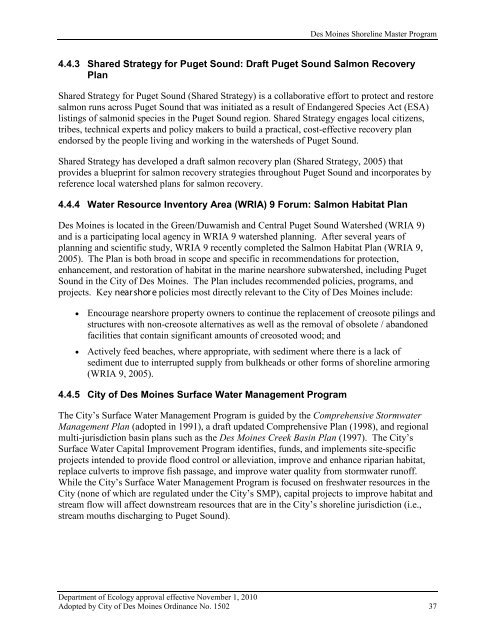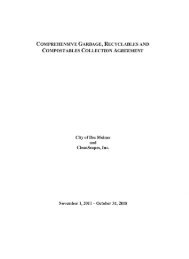CITY OF DES MOINES SHORELINE MASTER PROGRAM
CITY OF DES MOINES SHORELINE MASTER PROGRAM
CITY OF DES MOINES SHORELINE MASTER PROGRAM
You also want an ePaper? Increase the reach of your titles
YUMPU automatically turns print PDFs into web optimized ePapers that Google loves.
Des Moines Shoreline Master Program<br />
4.4.3 Shared Strategy for Puget Sound: Draft Puget Sound Salmon Recovery<br />
Plan<br />
Shared Strategy for Puget Sound (Shared Strategy) is a collaborative effort to protect and restore<br />
salmon runs across Puget Sound that was initiated as a result of Endangered Species Act (ESA)<br />
listings of salmonid species in the Puget Sound region. Shared Strategy engages local citizens,<br />
tribes, technical experts and policy makers to build a practical, cost-effective recovery plan<br />
endorsed by the people living and working in the watersheds of Puget Sound.<br />
Shared Strategy has developed a draft salmon recovery plan (Shared Strategy, 2005) that<br />
provides a blueprint for salmon recovery strategies throughout Puget Sound and incorporates by<br />
reference local watershed plans for salmon recovery.<br />
4.4.4 Water Resource Inventory Area (WRIA) 9 Forum: Salmon Habitat Plan<br />
Des Moines is located in the Green/Duwamish and Central Puget Sound Watershed (WRIA 9)<br />
and is a participating local agency in WRIA 9 watershed planning. After several years of<br />
planning and scientific study, WRIA 9 recently completed the Salmon Habitat Plan (WRIA 9,<br />
2005). The Plan is both broad in scope and specific in recommendations for protection,<br />
enhancement, and restoration of habitat in the marine nearshore subwatershed, including Puget<br />
Sound in the City of Des Moines. The Plan includes recommended policies, programs, and<br />
projects. Key nearshore policies most directly relevant to the City of Des Moines include:<br />
• Encourage nearshore property owners to continue the replacement of creosote pilings and<br />
structures with non-creosote alternatives as well as the removal of obsolete / abandoned<br />
facilities that contain significant amounts of creosoted wood; and<br />
• Actively feed beaches, where appropriate, with sediment where there is a lack of<br />
sediment due to interrupted supply from bulkheads or other forms of shoreline armoring<br />
(WRIA 9, 2005).<br />
4.4.5 City of Des Moines Surface Water Management Program<br />
The City’s Surface Water Management Program is guided by the Comprehensive Stormwater<br />
Management Plan (adopted in 1991), a draft updated Comprehensive Plan (1998), and regional<br />
multi-jurisdiction basin plans such as the Des Moines Creek Basin Plan (1997). The City’s<br />
Surface Water Capital Improvement Program identifies, funds, and implements site-specific<br />
projects intended to provide flood control or alleviation, improve and enhance riparian habitat,<br />
replace culverts to improve fish passage, and improve water quality from stormwater runoff.<br />
While the City’s Surface Water Management Program is focused on freshwater resources in the<br />
City (none of which are regulated under the City’s SMP), capital projects to improve habitat and<br />
stream flow will affect downstream resources that are in the City’s shoreline jurisdiction (i.e.,<br />
stream mouths discharging to Puget Sound).<br />
Department of Ecology approval effective November 1, 2010<br />
Adopted by City of Des Moines Ordinance No. 1502 37



